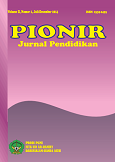PERILAKU DAN MOTIF PERUNDUNGAN SISWA MIN 2 ACEH TAMIANG
DOI:
https://doi.org/10.22373/pjp.v9i2.9002Keywords:
Bullying, Motive, BehaviorAbstract
This study aims to describe how bullying behavior and the motives of the bulliers. The research subjects were 5 victim students and 6 bullier students who came from grades IV and V of MI Negeri 2 Aceh Tamiang. The data collection technique using in-depth interviews and observations. The results of the study show the forms of bullying behavior, such as: verbal bullying (taunting and labeling). Physical bullying (pinching and pulling the veil), and indirect bullying (asking others to hurt). The motives of the bullier for bullying, among others, are feeling superior, resentful, and jealous.
References
Abdul, Muhammad, and Aziz Robbani. “Pengaruh Self-Concept Dan School Climate Terhadap Berprilaku Bullying Pada Masa Kanak-Kanak,” 2016.
Antasari, Antasari. Menyikapi Perilaku Agresif Anak. Yogyakarta: 2006, 2006.
Hidayati, Nurul. “Bullying Pada Anak: Analisis Dan Alternatif Solusi.” Jurnal Insan 14, no. 1 (2012): 41–48. http://www.journal.unair.ac.id/filerPDF/artikel 5-14-1.pdf.
Juvonen, Jaana, and Sandra Graham. “Bullying in Schools: The Power of Bullies and the Plight of Victims.” Annual Review of Psychology 65 (2014): 159–85. https://doi.org/10.1146/annurev-psych-010213-115030.
Menesini, Ersilia, and Christina Salmivalli. “Bullying in Schools: The State of Knowledge and Effective Interventions.” Psychology, Health and Medicine 22 (2017): 240–53. https://doi.org/10.1080/13548506.2017.1279740.
Sejiwa, Y. S. J. A. Bullying: Mengatasi Kekerasan. Jakarta: PT Grasindo., 2008.
Simbolon, M. (2012). “Perilaku Bullying Pada Mahasiswa Berasrama.” Jurnal Psikologi Vol. 39, no. NO. 2 (2012): 233–43.
Siti Nur Isnaini. “Dampak School Bullying Terhadap Kesehatan Mental Anak Sekolah Dasar Negeri Bilebante Di Desa Bilebante.” UIN Mataram, 2017.
Sucipto, Sucipto. “Bullying Dan Upaya Meminimalisasikannya.” PSIKOPEDAGOGIA Jurnal Bimbingan Dan Konseling, 1, no. 1 (2012): 34–45.
Toblin, Robin L., David Schwartz, Andrea Hopmeyer Gorman, and Tania Abou-ezzeddine. “Social-Cognitive and Behavioral Attributes of Aggressive Victims of Bullying.” Journal of Applied Developmental Psychology 26, no. 3 (2005): 329–46. https://doi.org/10.1016/j.appdev.2005.02.004.
Wiandari, Fadhillah, and Siti Habsari. “The Use Of Literature In Developing Students’ Characters Through Authentic Assessment.” JL3T Journal of Linguistics, Literature & Language Teaching Vol. IV, no. JL3T. Vol. IV, No. 2 December 2018 (2018): 76–97. https://www.journal.iainlangsa.ac.id/index.php/jl3t/article/view/758.
Wiyani, N. A. “No Title.” In Save Our Children from School Bullying. J. Jogjakarta: Ar-Ruzz Media., 2012.
Yunika, Riri, Alizamar Alizamar, and Inda Sukmawati. “Upaya Guru Bimbingan Dan Konseling Dalam Mencegah Perilaku Bullying Di SMA Negeri Se Kota Padang.” Konselor 2, no. 3 (2013): 21–25. https://doi.org/10.24036/02013232163-0-00.
Downloads
Published
Issue
Section
License
- Authors retain copyright and grant the journal right of first publication with the work simultaneously licensed under a Creative Commons Attribution License that allows others to share the work with an acknowledgment of the work's authorship and initial publication in this journal.
- Authors are able to enter into separate, additional contractual arrangements for the non-exclusive distribution of the journal's published version of the work (e.g., post it to an institutional repository or publish it in a book), with an acknowledgment of its initial publication in this journal.
- Authors are permitted and encouraged to post their work online (e.g., in institutional repositories or on their website) prior to and during the submission process, as it can lead to productive exchanges, as well as earlier and greater citation of published work (See The Effect of Open Access).

